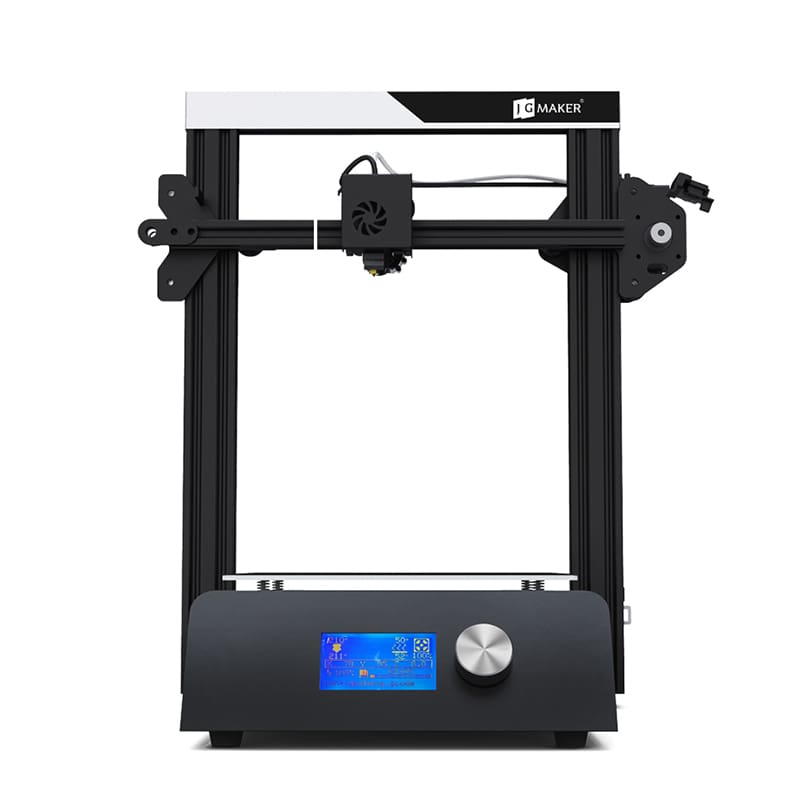The JGMaker Magic is a compact desktop 3D printer manufactured by the Shenzen Aurora Technology Company, which currently releases printer under the JGMaker brand – formerly JGAurora.
With a print volume of 220 x 220 x 250 mm, a Bowden extruder, modular design, and a price tag of about $200, the JGMaker Magic has much in common with the hugely popular Ender 3 series of printers. But how does it stack up?
Read on as we review the specs to find out.
Features
Let’s see what the JGMaker Magic has in its hat.
Sturdy Metal Base
The JGMaker Magic has an all-metal frame, and the bottom of the machine is a hefty metal base unit providing the needed weight to give stability. This base also houses the power supply, touchscreen, and rotary knob – giving the printer a sleek and tidy appearance.
In general, a sturdy frame reduces vibrations from the machine’s movements, resulting in less Z-wobble and ensuring a smoother finish of prints.
As the JGMaker Magic requires manual bed leveling, a sturdy frame should cut back on the need to continually re-level the bed.
Removable Build Plate
The 220 x 220 mm sized heated bed on the JGMaker Magic features a removable flexible build plate that should provide decent adherence for your prints. Naturally, a removable bed also makes print removal a lot easier than hacking at a bed that is fixed to the printer.
Seeing as the JGMaker Magic is an Ender 3 clone of sorts, we guess the platform in use is similar to the Ender 3 Pro’s magnetic build plate.
Resume Functions
The JGMaker Magic offers not one, but three resume print functions. Alongside the somewhat common power outage resume and the filament runout detection, the Magic also features a resume print function, should you accidentally remove the SD card.
It’s a development on a nice-to-have feature and one that should spare you some unpleasant print-ending surprises.
DIY-Assembly
Unlike most budget printers today, the JGMaker Magic requires a few more flicks of the wrist to get up and running. Instead of mounting the assembled gantry to the base, the JGMaker Magic’s frame and Z-axis need to be assembled by the user – a rarity nowadays.
With neatly labeled and individually packed screws, the assembly should not take longer than a couple of hours, even for complete novices.

Tech Specs

General Specifications
- Technology: Fused deposition modeling (FDM)
- Year: 2019
- Assembly: Partially assembled
- Mechanical arrangement: Cartesian-XZ-head
- Manufacturer: JGMaker
3D Printer Properties
- Build volume: 220 x 220 x 250 mm
- Feeder system: Bowden drive
- Print head: Single nozzle
- Nozzle size: 0.4 mm
- Max. hot end temperature: 240 ℃
- Max. heated bed temperature: 110 ℃
- Print bed material: Removable magnetic sheet
- Frame: Aluminum
- Bed leveling: Manual
- Connectivity: SD card, USB cable
- Print recovery: Yes
- Filament sensor: Yes
- Camera: No
Materials
- Filament diameter: 1.75 mm
- Third-party filament: Yes
- Filament materials: Consumer materials (PLA, ABS, PETG, Flexibles)
Software
- Recommended slicer: Cura, Simplify3D, Repetier-Host
- Operating system: Windows, Mac OSX, Linux
- File types: STL, OBJ, AMF
Dimensions and Weight
- Frame dimensions: 450 x 443 x 472 mm
- Weight: 8 kg

Similar Printers
You may also be interested in the following printers:
For even more printers, check out our guide to the best budget 3D printers.
Creality Ender 3 V2
The Ender 3 V2 is Creality’s newest iteration of its immensely popular Ender 3 series. It features the same print volume ( 220 x 220 x 250 mm) as the JGMaker Magic as well as a Bowden extruder, and Ultrabase-like coated glass platform.
Artillery Genius
The Artillery Genius costs about $100 more than the Magic, but comes with a direct drive extruder and a fast-heating AC-powered print bed.
Creality CR-6 SE
The Creality CR-6 SE shares some resemblance to Creality’s Ender 3 V2, sharing many of its features but offering a slightly larger build volume (235 x 235 x 250 mm) and automatic bed leveling. The product of Creality’s first-ever Kickstarter, the CR-6 SE won’t be available for a while still, but we went hands-on with a preview unit and it’s certainly one to keep an eye on.
License: The text of "JGAurora/JGMaker Magic 3D Printer: Review the Specs" by All3DP is licensed under a Creative Commons Attribution 4.0 International License.
CERTAIN CONTENT THAT APPEARS ON THIS SITE COMES FROM AMAZON. THIS CONTENT IS PROVIDED ‘AS IS’ AND IS SUBJECT TO CHANGE OR REMOVAL AT ANY TIME.





